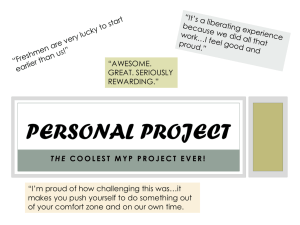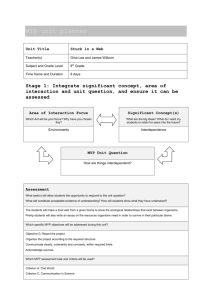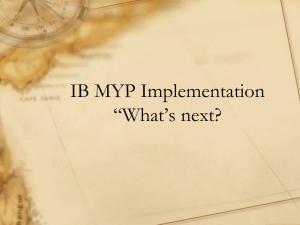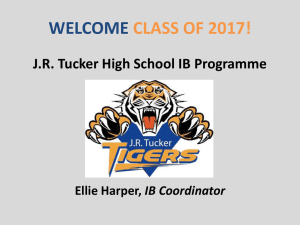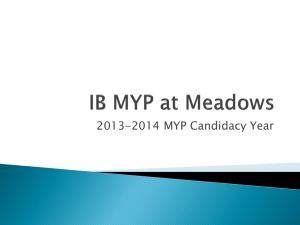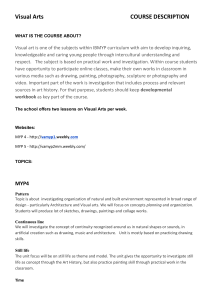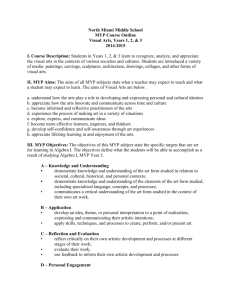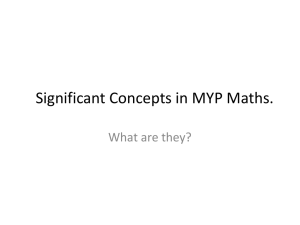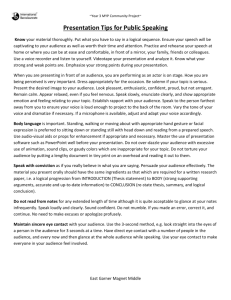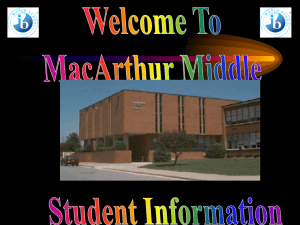Overview of the Study
advertisement
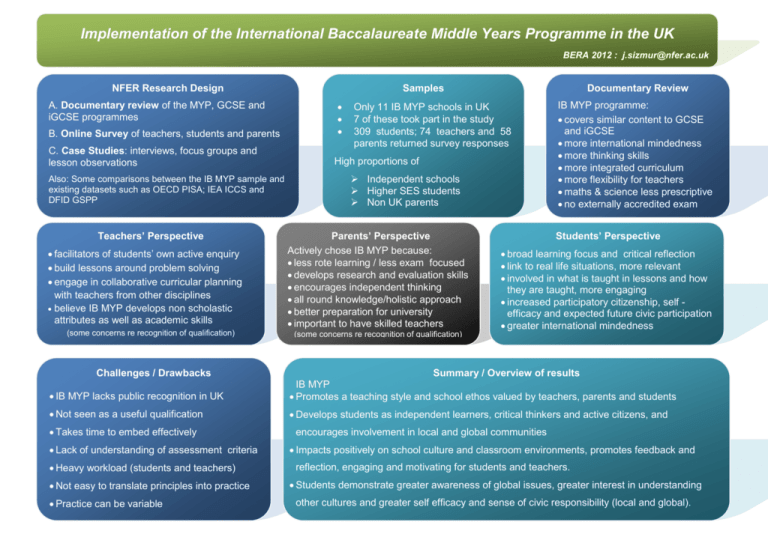
Implementation of the International Baccalaureate Middle Years Programme in the UK BERA 2012 : j.sizmur@nfer.ac.uk NFER Research Design A. Documentary review of the MYP, GCSE and iGCSE programmes B. Online Survey of teachers, students and parents C. Case Studies: interviews, focus groups and lesson observations Also: Some comparisons between the IB MYP sample and existing datasets such as OECD PISA; IEA ICCS and DFID GSPP Teachers’ Perspective facilitators of students’ own active enquiry build lessons around problem solving engage in collaborative curricular planning with teachers from other disciplines believe IB MYP develops non scholastic attributes as well as academic skills (some concerns re recognition of qualification) Challenges / Drawbacks Samples Documentary Review Only 11 IB MYP schools in UK 7 of these took part in the study 309 students; 74 teachers and 58 parents returned survey responses High proportions of Independent schools Higher SES students Non UK parents Parents’ Perspective Actively chose IB MYP because: less rote learning / less exam focused develops research and evaluation skills encourages independent thinking all round knowledge/holistic approach better preparation for university important to have skilled teachers (some concerns re recognition of qualification) IB MYP programme: covers similar content to GCSE and iGCSE more international mindedness more thinking skills more integrated curriculum more flexibility for teachers maths & science less prescriptive no externally accredited exam Students’ Perspective broad learning focus and critical reflection link to real life situations, more relevant involved in what is taught in lessons and how they are taught, more engaging increased participatory citizenship, self efficacy and expected future civic participation greater international mindedness IB MYP lacks public recognition in UK Summary / Overview of results IB MYP Promotes a teaching style and school ethos valued by teachers, parents and students Not seen as a useful qualification Develops students as independent learners, critical thinkers and active citizens, and Takes time to embed effectively Lack of understanding of assessment criteria Heavy workload (students and teachers) Not easy to translate principles into practice Practice can be variable encourages involvement in local and global communities Impacts positively on school culture and classroom environments, promotes feedback and reflection, engaging and motivating for students and teachers. Students demonstrate greater awareness of global issues, greater interest in understanding other cultures and greater self efficacy and sense of civic responsibility (local and global). Case study vignette: Lesson observation Debating Rita: What is art? In this case study school, the Year 11 English students were studying Educating Rita through both the film and the text. In the observed lesson, the students were examining an extract from the text, where Rita dismisses E.M. Forster’s Howard’s End as ‘crap’. Her criticism rests on the fact that midway through the book, Forster states that ‘We are not concerned with the poor’, which she finds morally reprehensible. In contrast, her tutor, Frank, states that ‘In criticism, sentiment has no place’. The lesson had a varied structure. First, two students acted out the extract from the text while the others listened. Following this, the class split into groups and each was assigned a key question to discuss. These included: What is Rita hoping to achieve by studying literature? Do you agree with Frank’s ideas about good criticism? How justifiable is Rita’s rejection of Forster? The students then reconvened to share what they had discussed with the rest of the class. This discussion was very open and interactive, and all students seemed highly engaged. The classroom was laid out with the students’ desks all facing each other and the teacher circulated the room. In discussing the first question above, some students suggested that Rita decided to go to university to give her life meaning. The teacher challenged the students to consider whether meaning necessarily follows higher education. Later, in his interview, he said that he was trying to get the students to be ‘socially articulate about their own position’. Many of these students consider university a natural next step, rather than a decision, and he wanted to make them aware of their own social standing. Indeed, one of the students expressed this in class, by saying that going to university is the stereotype for students like them: ‘it is what is expected of us’. In discussing the later key questions about literary criticism, the students disagreed with each other about whether or not Rita’ judgment was justifiable. Some felt that her own emotional reaction to the book constituted a valid opinion, which contravenes Frank’s assertion that criticism should be objective. These differing views led to a debate on the nature of art, which was facilitated by the teacher. This was not part of the lesson plan and developed naturally from the class discussion. The teacher introduced the students to the idea that art could be judged based on three dimensions: The artist: does the artist’s life and background matter? The observer: does your own reaction to it matter? The art’s aesthetic value: does it need to be beautiful? He then asked the students to volunteer their position on which of these three dimensions is most important for them. At this point in the lesson, the teacher encouraged full-class participation. He asked the students to stop raising their hands and just join in the debate. When a student appeared reticent he would draw them into the discussion: ‘I want to hear from you next’. He illustrated the first dimension (art in the context of the artist’s life) by showing them Van Gogh’s ‘Wheatfield with Crows’. Again, this was not planned; he had an internet connection on his computer and just searched for the painting online. He gave them some time to look at it and then asked them if their opinion or interpretation would change if he told them this was Van Gogh’s last painting before he committed suicide. Some students felt that this did change their perspective, for example, by making the black crows in the painting seem ominous in a way they had not before. Overall, this lesson was interactive, engaging and quite freeform. The teacher challenged the students to articulate their opinions and justify their views, while respecting the perspectives of others. Lesson observation and teacher interview (English, School 3)
